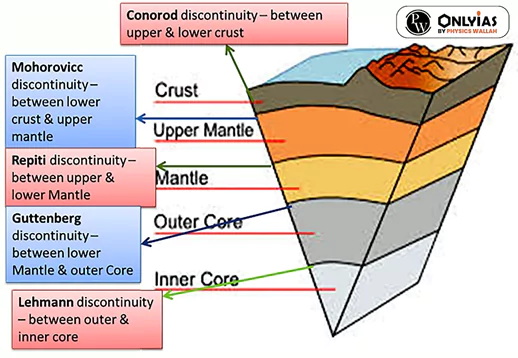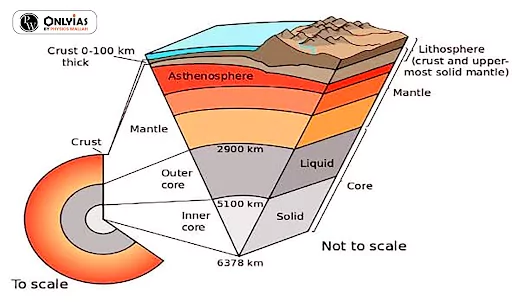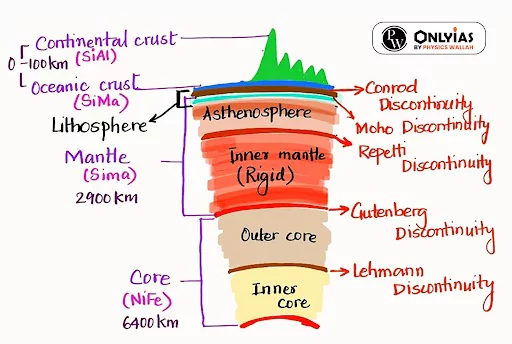Introduction: Exploring the Depths Below Our Feet in the Earth’s Interior
The interior of the Earth is a hidden world of incredible complexity and mystery. Like all terrestrial planets, the Earth’s interior is differentiated. This means that its internal structure consists of layers, arranged like the skin of an onion. Beneath the Earth’s solid outer crust lies a layered structure composed of the mantle, outer core, and inner core. Understanding these layers is essential for comprehending the planet’s geology, seismic activity, and the generation of Earth’s magnetic field.
The Interior of the Earth: An overview of Earth’s layers
The interior of the Earth is a realm of profound geological and physical complexity. It is divided into several distinct layers, each with its unique properties and significance in the planet’s overall dynamics.
Direct Insights into the interior of the earth from Surface Rocks, Deep Mines, and Volcanic Eruptions
- Surface Rock and Mining: Surface rock and materials obtained from mining areas serve as easily accessible sources for studying the Earth’s composition.
- Deep mining operations, such as gold mines in South Africa, have provided insights into the interior of the Earth’s crust up to depths of 3 – 4 km.
- Projects like the “Deep Ocean Drilling Project” and “Integrated Ocean Drilling Project” aim to penetrate deeper into the Earth’s crust to gather data from various depths.
- The Kola borehole in the Arctic Ocean, reaching 12 km in depth, has contributed substantial information through material analysis.
- Volcanic Eruptions: Volcanic eruptions supply molten material (magma) that becomes available for laboratory analysis.
- However, determining the magma’s source depth can be challenging.
Understanding the Earth’s Secrets with the help of indirect Clues from Matter Properties, Meteors, Gravity, Magnetism, and Seismic Activity”
- Analysis of Matter Properties: Temperature and pressure increase with depth in the interior of the Earth’s from surface to the interior.
- Material density also rises with depth.
- By understanding the rate of change of these properties and considering the Earth’s total thickness, scientists estimate temperature, pressure, and material density at various depths within the Earth’s layers.
- Meteors: At times, meteors reach Earth, providing material for analysis.
- While this material does not originate from the interior of the earth, it shares similarities with the Earth’s composition, offering insights into our planet’s composition.

- Gravitation: Gravitational force (g) varies at different latitudes due to the Earth’s shape, with greater values near the poles and lesser values at the equator.
- Uneven distribution of mass within the interior of the Earth affects gravity readings, resulting in gravity anomalies that reveal information about the distribution of materials in the Earth’s crust.
- Magnetic Field: Magnetic surveys help identify the distribution of magnetic materials in the interior of earth(crust).
- These surveys provide valuable information about the distribution of materials in the crustal portion.
- Seismic Activity: Seismic activity is a pivotal source of information about the interior of the Earth.
- Seismic waves generated by earthquakes help scientists determine the Earth’s internal structure and composition through their behaviour and interactions with different layers.
Two Distinct Ways to Divide the Earth: Mechanically and Chemically
- Mechanical: It considers the material’s physical properties.
- Chemical: It takes into account the Earth’s elemental composition.
Discovering the Mechanical Layers in the interior of the earth from Lithosphere to Inner Core
- Lithosphere: The rigid outer layer of the Earth, comprising the crust and the uppermost part of the mantle.
- It is characterised by its brittle behaviour and includes the Earth’s solid surface where tectonic plates interact.
- Asthenosphere: A partially molten, ductile layer beneath the lithosphere.
- The asthenosphere allows for the movement of tectonic plates due to its semi-fluid properties.
- Mesospheric Mantle: A region in the mantle deeper than the asthenosphere, exhibiting increased pressure and temperature.
- Outer Core: The layer beneath the mesospheric mantle, composed of molten iron and nickel.
- Its fluid nature generates the Earth’s magnetic field through the geodynamo process.
- Inner Core: The interior of the Earth’s central, solid core, predominantly consisting of iron and nickel.
- It maintains a solid state due to extreme pressures, even though temperatures reach up to 5,700 degrees Celsius.
Earth’s Chemical Division: Crust, Mantle, and Core
- Crust: Comprising less than 1% of Earth’s total mass, the crust encompasses the oceanic crust and continental crust.
- The continental crust typically consists of rock, while the oceanic crust is denser.
- Mantle: Representing approximately 68% of the Earth’s mass, the mantle is a hot layer beneath the crust.
- It can be further subdivided into the upper mantle and lower mantle, both influencing geological processes.
- Core: Constituting about 31% of Earth’s total mass, the core is primarily composed of iron metal.
- It can be distinguished into the outer core and inner core, with the outer core being molten and the inner core remaining solid due to immense pressure.
Revealing the outermost layer in the interior of the earth’s the Crust’s Composition, Thickness, and Diversity
- Physical Characteristics: The Earth’s crust is the planet’s outermost layer, providing a solid foundation for all terrestrial activities.
- Despite its solid nature, the crust is relatively fragile.
- Thickness Variations: The thickness of the Earth’s crust is not uniform.
- On average, the oceanic crust measures about 5 kilometres in thickness, while the continental crust is substantially thicker, with an average thickness of approximately 30 kilometres.
- In mountainous regions, the continental crust can reach depths of up to 70 kilometres.
- Density and Composition: Continental crust is composed of denser rocks, primarily granite, and exhibits a density of approximately 2.7 grams per cubic centimetre (g/cm³).
- Oceanic crust primarily consists of basalt rock, characterised by a mean density of about 3 g/cm³.
- Discontinuities:The boundary between the continental crust and oceanic crust is referred to as the “Conrad Discontinuity.”
- The boundary between the Earth’s crust and the upper portion of the mantle is known as the “Mohorovicic (Moho) Discontinuity.”

- Volume and Chemical Composition: The crust represents a mere 1% of the Earth’s total volume, making it a relatively thin outer layer.
- Chemical composition varies between the upper crust (continental crust) and the lower crust (oceanic crust).
- The upper crust is rich in lighter silicate minerals, primarily composed of silica and aluminium, forming the “SiAl” layer.
- In contrast, the lower crust contains heavier silicates, mainly composed of silica and magnesium, creating the “SiMa” layer.
- This compositional distinction results in the oceanic crust being denser than the continental crust.
Exploring Earth’s Mantle’s Structure, Dynamics, and Geological Impact
- Extent and Volume: The mantle encompasses the region between the Mohorovicic (Moho) Discontinuity and the outer core (Gutenberg Discontinuity) and extends to a depth of approximately 2,900 kilometres (km) below the Earth’s surface.
- This vital layer constitutes a substantial 83% of the Earth’s total volume.
- Internal Subdivisions: The mantle can be divided into distinct regions: the upper mantle, the asthenosphere, and the lower mantle.

- Lithosphere: The lithosphere combines the lower crust and the uppermost part of the mantle.
- It forms a hard, rocky layer with variable thickness, typically ranging from 10 to 120 km.
- The lithosphere represents the Earth’s solid outermost layer.
- Asthenosphere: Situated just beneath the lithosphere at depths between approximately 80 and 200 km, the asthenosphere is in a plastic state, neither fully solid nor liquid.
- The asthenosphere is a crucial source of magma that ascends to the Earth’s surface during volcanic eruptions.
- Lower Mantle: Extending from the Repetti Discontinuity to the Gutenberg Discontinuity, the lower mantle represents a solid and rigid layer.
- Diverse Densities: The mantle exhibits variable densities, with the upper mantle having a density of around 2.9 grams per cubic centimetre (g/cm³) and the lower mantle reaching densities of about 5.7 g/cm³.
- Solid State Under High Pressure: Except for the asthenosphere, the mantle remains in a solid state despite its high temperatures, owing to the elevating pressure, which raises the melting point of rocks.
- Driving Geological Processes: Convection within the mantle serves as the driving force for various geological processes, including plate tectonics, seafloor spreading, earthquakes, volcanoes, and the formation of mountain ranges (orogeny).
- Chemical Composition: The mantle primarily consists of heavier silicate materials, featuring silica and magnesium in composition, similar to the lower crust.
Core: The Earth’s Innermost Layer of Mystery and Magnetism
- Depth and Volume: The core is the innermost layer of the Earth, lying at depths between 2,900 kilometres to approximately 6,400 kilometres beneath the surface.
- Despite its compact size, the core accounts for approximately 16% of the Earth’s total volume.
- Composition and Nickname: Comprising heavy materials, primarily iron and nickel, the core is often referred to as the “NiFe” layer.
- Due to its concentration of dense elements, the core contributes significantly to the Earth’s mass, making up about 33% of the planet’s total mass.
- Layered Structure: The core consists of two distinct layers: the outer core and the inner core, separated by the Lehmann Discontinuity.
- Outer Core: Situated between the depths of approximately 2,900 kilometres to 5,150 kilometres, the outer core is in a liquid state.
- This molten layer plays a critical role in generating the Earth’s magnetic field.
- Inner Core: Extending from about 5,150 kilometres to the core’s innermost boundary, the inner core is rigid and solid.
- The extreme pressure at this depth prevents the inner core from melting despite the high temperatures.
- The Magnetic Dynamo: The dynamic movement of the liquid outer core is responsible for the creation of the Earth’s magnetic field. This process, known as the geodynamo, shields our planet from harmful solar radiation and contributes to the conditions necessary for life on Earth.
Do You Know:
- Sequence of discontinuity: Moho Discontinuity – Asthenosphere – Gutenberg Discontinuity – Lehmann Discontinuity































